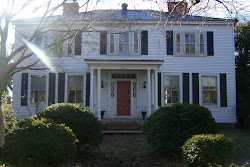Well, horse hair, at least. The original walls and ceilings that remain in the house are plaster - horse hair plaster. I'm fascinated by it and in awe of it. Now that this has been pointed out to me, every time I look at the walls, I cannot help but imagine the horses who contributed their hair to the plaster cause. They lived over 100 years ago, and not only did they probably provide years of service to those who lived in the early 1900's, their hair is now deeply embedded in our walls.
Check out this close up of the horse hair from a chunk of plaster:
Lime plaster was generally used during the time that Glenlochan was built (although gypsum plaster also arrived on the scene in the early 1900's). Although I'm not a plaster expert by any means, it's interesting to note that the 4 ingredients for lime plaster are: Lime, aggregate, fiber, and water. The lime came from limestone or oyster shells (did I mention that Urbanna is famous for it's annual Oyster Festival?). The aggregate was generally sand, and horse hair (in the case or our plaster) or boar's hair served as the fiber. Applied in 3 layers over wooden lath, plaster walls provided strength, durability, noise reduction, and fire resistance. Here's a look at the wooden lath.
One of the downsides of lime plaster was that it could take over a year to dry and cure before paint or wallpaper could be applied.
We have several options to consider as we put together our renovation plans, each of which come with various advantages, disadvantages, and price points. Repairing the plaster, where possible makes sense, but some areas are too far gone for mere repairs. Drywalling over the plaster would probably be the most economical, but it isn't historically accurate. (I should note that this is the option that a previous owner had already elected in many of the downstairs rooms of the home, and we aren't exactly thrilled with the results.) Re-plastering is probably the most expensive option, and it requires a very skilled craftsman. A middle of the road option is veneer plaster - a modern method of plastering that is more expensive than drywall, but not as costly as traditional plaster. We have lots to think about.
"Plaster in a historic building is like a family album. The handwriting of the artisans, the taste of the original occupants, and the evolving styles of decoration are embodied in the fabric of the building." Preservation Brief 21 of the Department of the Interior We look forward to adding our unique touch to the fabric of Glenlochan.



No comments:
Post a Comment